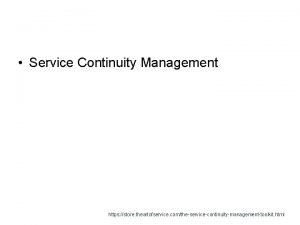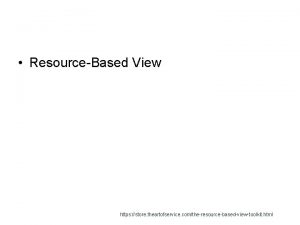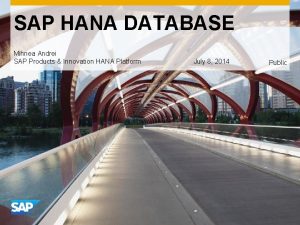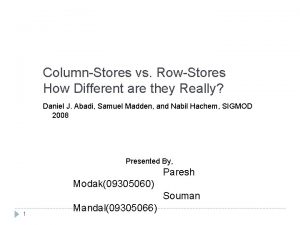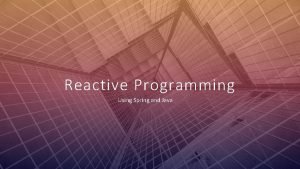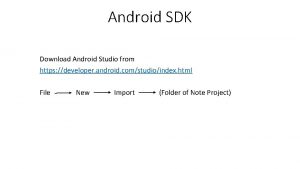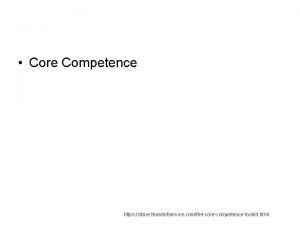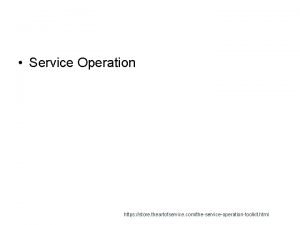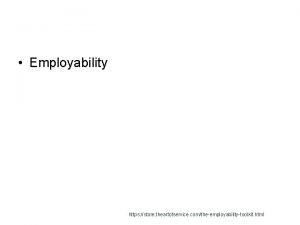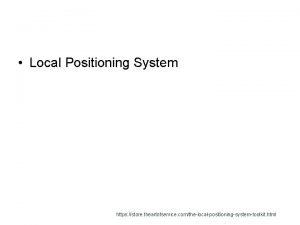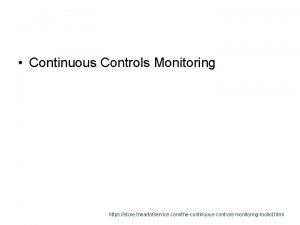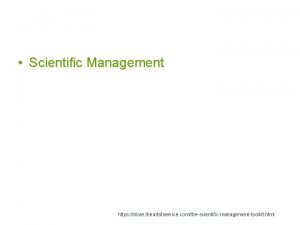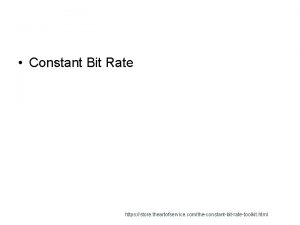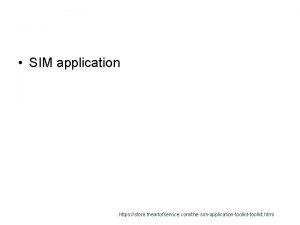Reactive Programming https store theartofservice comthereactiveprogrammingtoolkit html Reactive






















- Slides: 22

• Reactive Programming https: //store. theartofservice. com/the-reactive-programming-toolkit. html

Reactive programming 1 In computing, 'reactive programming' is a programming paradigm oriented around Dataflow programming|data flows and the propagation of change. This means that it should be possible to express static or dynamic data flows with ease in the programming languages used, and that the underlying execution model will automatically propagate changes through the data flow. https: //store. theartofservice. com/the-reactive-programming-toolkit. html

Reactive programming 1 In reactive programming, the value of a would be automatically updated based on the new values. https: //store. theartofservice. com/the-reactive-programming-toolkit. html

Reactive programming A modern spreadsheet program is an example of reactive programming. Spreadsheet cells can contain literal values, or formulas such as =B 1+C 1 that are evaluated based on other cells. Whenever the value of the other cells change, the value of the formula is automatically updated. 1 https: //store. theartofservice. com/the-reactive-programming-toolkit. html

Reactive programming 1 Another example is a hardware description language such as Verilog. In this case reactive programming allows us to model changes as they propagate through a circuit. https: //store. theartofservice. com/the-reactive-programming-toolkit. html

Reactive programming 1 Reactive programming has foremost been proposed as a way to simplify the creation of interactive user interfaces, animations in real time systems, but is essentially a general programming paradigm. https: //store. theartofservice. com/the-reactive-programming-toolkit. html

Reactive programming 1 For example, in a Model-view-controller architecture, reactive programming can allow changes in the underlying model to automatically be reflected in the view, and vice versa. . https: //store. theartofservice. com/the-reactive-programming-toolkit. html

Reactive programming - Degrees of explicitness Reactive programming libraries for dynamic languages (such as the Lisp Cells and Python Trellis libraries) can construct a dependency graph from runtime analysis of the values read during a function's execution, allowing data flow specifications to be both implicit and dynamic. 1 https: //store. theartofservice. com/the-reactive-programming-toolkit. html

Reactive programming - Degrees of explicitness 1 Sometimes the term reactive programming refers to the architectural level of software engineering, where individual nodes in the data flow graph are ordinary programs that communicate with each other. https: //store. theartofservice. com/the-reactive-programming-toolkit. html

Reactive programming - Static or Dynamic 1 Reactive programming can be purely static where the data flows are set up statically, or be dynamic where the data flows can change during the execution of a program. https: //store. theartofservice. com/the-reactive-programming-toolkit. html

Reactive programming - Static or Dynamic 1 The use of data switches in the data flow graph could to some extent make a static data flow graph appear as dynamic, and blur the distinction slightly. True dynamic reactive programming however could use imperative programming to reconstruct the data flow graph. https: //store. theartofservice. com/the-reactive-programming-toolkit. html

Reactive programming - Higher-order reactive programming 1 Reactive programming could be said to be of 'higher order' if it supports the idea that data flows could be used to construct other data flows. That is, the resulting value out of a data flow is another data flow graph that is executed using the same evaluation model as the first. https: //store. theartofservice. com/the-reactive-programming-toolkit. html

Reactive programming - Data flow differentiation Ideally all data changes are propagated instantly, but this cannot be assured in practice. Instead it might be necessary to give different parts of the data flow graph different evaluation priorities. This can be called 'differentiated reactive programming'. 1 https: //store. theartofservice. com/the-reactive-programming-toolkit. html

Reactive programming - Data flow differentiation For example, in a word processor the marking of spelling errors need not be totally in sync with the inserting of characters. Here differentiated reactive programming could potentially be used to give the spell checker lower priority, allowing it to be delayed while keeping other data-flows instantaneous. 1 https: //store. theartofservice. com/the-reactive-programming-toolkit. html

Reactive programming - Evaluation models of reactive programming One inherent problem for reactive programming is that most computations that would be evaluated and forgotten in a normal programming language, needs to be represented in the memory as datastructures. This could potentially make RP highly memory consuming. However, research on what is called lowering could potentially overcome this problem. . 1 https: //store. theartofservice. com/the-reactive-programming-toolkit. html

Reactive programming - Evaluation models of reactive programming 1 On the other side, reactive programming is a form of what could be described as explicit parallelism, and could therefore be beneficial for utilizing the power of parallel hardware. https: //store. theartofservice. com/the-reactive-programming-toolkit. html

Reactive programming - Similarities with observer pattern Reactive programming has principal similarities with the observer pattern commonly used in object-oriented programming. However, integrating the data flow concepts into the programming language would make it easier to express them, and could therefore increase the granularity of the data flow graph. For example, the observer pattern commonly describes data-flows between whole objects/classes, whereas object-oriented reactive programming could target the members of objects/classes. 1 https: //store. theartofservice. com/the-reactive-programming-toolkit. html

Reactive programming - Imperative 1 It is possible to fuse reactive programming with ordinary imperative programming. In such a paradigm, imperative programs operate upon reactive data structures. . Such a set-up is analogous to constraint imperative programming; however, while constraint imperative programming manages bidirectional constraints, reactive imperative programming manages oneway dataflow constraints. https: //store. theartofservice. com/the-reactive-programming-toolkit. html

Reactive programming - Object-oriented reactive programming (OORP) is a combination of object oriented programming and reactive programming. Perhaps the most natural way to make such a combination is as follows: Instead of methods and fields, objects have reactions that automatically re-evaluate when the other reactions they depend on have been modified. Below an illustration of the A=X+Y introductory example: . 1 https: //store. theartofservice. com/the-reactive-programming-toolkit. html

Reactive programming - Object-oriented If an OORP programming language maintains its imperative methods, it would also fall under the category of imperative reactive programming. 1 https: //store. theartofservice. com/the-reactive-programming-toolkit. html

Reactive programming - Functional reactive programming| Functional reactive programming (FRP) is a programming paradigm for reactive programming on functional programming. 1 https: //store. theartofservice. com/the-reactive-programming-toolkit. html

For More Information, Visit: • https: //store. theartofservice. co m/the-reactive-programmingtoolkit. html The Art of Service https: //store. theartofservice. com
 Theartofservice
Theartofservice Theartofservice
Theartofservice Row store vs column store
Row store vs column store Row store vs column store
Row store vs column store Reactive extensions net core
Reactive extensions net core Reactive manifesto
Reactive manifesto Canvas доска
Canvas доска Html
Html Doctype html html head
Doctype html html head Doctype html html head
Doctype html html head 1
1 Store.unity.com
Store.unity.com Perbedaan linear programming dan integer programming
Perbedaan linear programming dan integer programming Greedy vs dynamic
Greedy vs dynamic System programming vs application programming
System programming vs application programming Linear vs integer programming
Linear vs integer programming Definisi linear
Definisi linear Portal nbed
Portal nbed Https://www.mathsgenie.co.uk/gcse.html
Https://www.mathsgenie.co.uk/gcse.html Https://www.mathsgenie.co.uk/gcse.html
Https://www.mathsgenie.co.uk/gcse.html Docs python turtle
Docs python turtle Https://docs. python.org/3/library/index.html
Https://docs. python.org/3/library/index.html Https developer android com studio index html
Https developer android com studio index html
